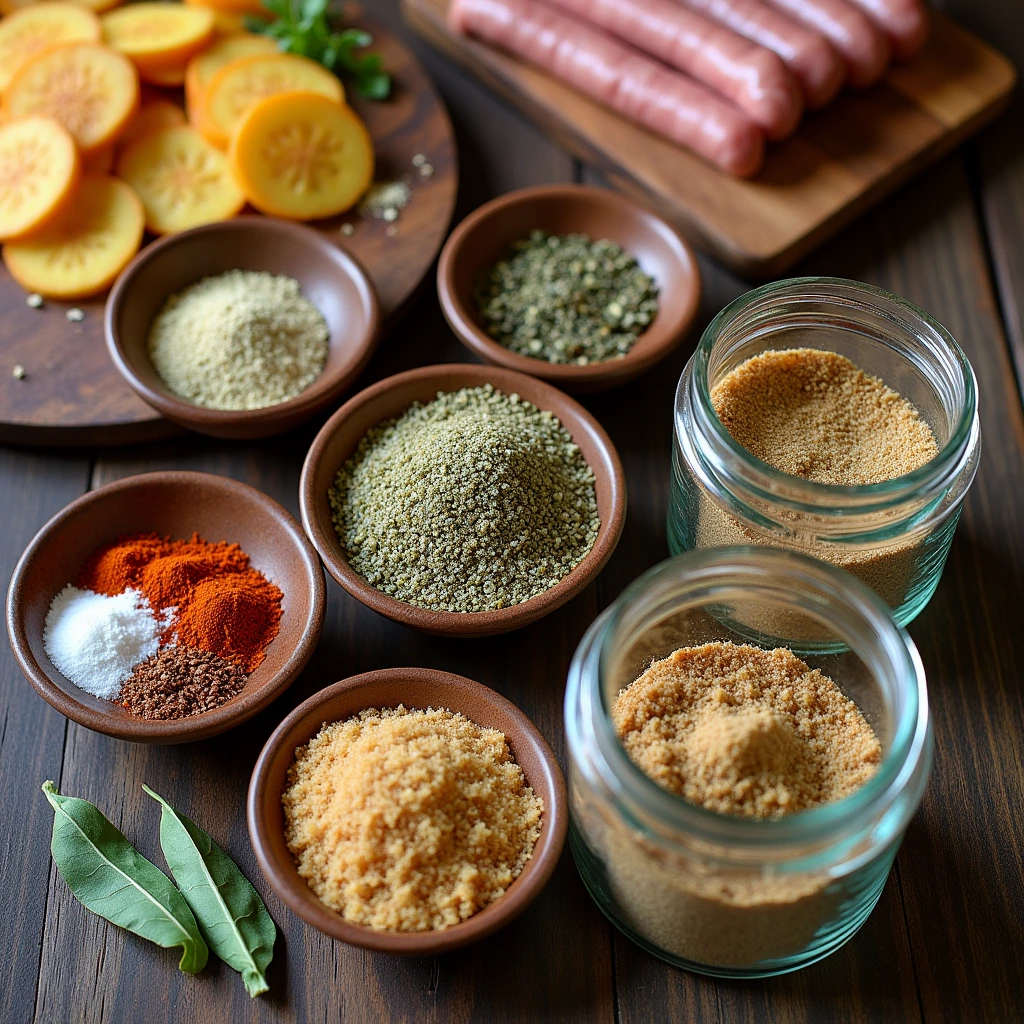A perfectly crafted breakfast sausage seasoning can take your morning meals from basic to extraordinary. Whether you’re preparing classic sausage patties, mixing it into breakfast casseroles, or seasoning other savory dishes, a homemade seasoning blend allows you to control the ingredients. This ensures freshness and flavor without the artificial additives often found in pre-made mixes. By creating your own seasoning, you can adjust spice levels and tailor it to your unique taste preferences. Ultimately, it enhances your breakfast experience.
What Is Breakfast Sausage Seasoning?
Breakfast sausage seasoning is a combination of spices and herbs that define the flavor profile of sausage. It gives the sausage a savory, slightly sweet, and aromatic taste. Traditional seasoning mixes balance savory, sweet, and spicy elements to create a well-rounded flavor. While there are many pre-made seasoning blends available, making your own offers the advantage of fresher ingredients. Additionally, it allows you to adjust flavors to suit your tastes. Homemade seasoning blends also avoid preservatives, MSG, or artificial colors, making it a healthier and more customizable option.
This seasoning mix isn’t just limited to sausage, though. It can be a fantastic addition to other dishes. Try it in breakfast casseroles, roasted vegetables, soups, or even grilled meats. With its ability to enhance a variety of recipes, homemade breakfast sausage seasoning becomes an incredibly versatile tool in your kitchen.
Why Make Your Own Breakfast Sausage Seasoning?
Making your own breakfast sausage seasoning offers several advantages over buying pre-made blends:
- Freshness: Homemade seasoning blends use fresh, natural spices and herbs that retain their vibrant flavor. Store-bought mixes, on the other hand, often contain preservatives or artificial ingredients that diminish the overall taste. When you create your own seasoning, you know exactly what goes into it, and you can avoid any unwanted additives.
- Customization: One of the biggest benefits of making your own seasoning is the ability to adjust it to your taste. You can control the level of spice, sweetness, and herbiness in your mix. For example, if you prefer a sweeter sausage, you can add more brown sugar or maple powder. If you like it spicier, you can add more cayenne or red pepper flakes. It’s entirely up to you.
- Cost-Effective: Buying spices in bulk and making your own seasoning mix is much more affordable than buying small packets of pre-mixed seasoning. Plus, making large batches of seasoning ensures you have it on hand for many future meals. This saves you both time and money in the long run.
- Healthier Option: Homemade seasoning allows you to control the amount of salt and sugar. This helps you avoid the high sodium content or excessive sugar found in many store-bought blends. You can even experiment with salt substitutes or use low-sodium ingredients to make your seasoning healthier.
In addition to sausage, you can incorporate this versatile seasoning into many other dishes. For instance, you can try it in scrambled eggs, roasted potatoes, or even as a seasoning for grilled chicken. Its ability to add depth of flavor to a wide range of dishes makes it an invaluable staple in any kitchen.
Key Components of Breakfast Sausage Seasoning
A well-balanced breakfast sausage seasoning includes a variety of flavors that complement one another. The combination of savory herbs, sweet elements, and spices creates a distinctive profile that’s characteristic of traditional breakfast sausage.
Key Ingredients:
- Savory Spices: Sage, thyme, and fennel seeds are the pillars of a classic breakfast sausage seasoning. Sage provides a deep, earthy flavor. Thyme adds a subtle, aromatic note. Fennel seeds lend a sweet, slightly licorice-like taste that’s essential to the traditional breakfast sausage flavor.
- Sweet Elements: A small amount of brown sugar, maple powder, or honey balances out the savory herbs with a touch of sweetness. This sweetness is crucial for that iconic breakfast sausage taste. It provides contrast to the richness of the meat and spices.
- Spice and Heat: To add complexity and warmth to the seasoning, a pinch of cayenne pepper or red pepper flakes can be incorporated. This subtle heat helps elevate the flavor profile without overpowering it.
- Basic Seasonings: Salt and black pepper are essential for bringing all the ingredients together. These seasonings enhance the overall flavor and make the seasoning more balanced.
Regional Variations:
You can also customize your seasoning mix based on regional preferences. For example:
- Southern Style: Southern breakfast sausage often features bold flavors with spices like paprika, chili powder, and cayenne. These spices give it a smoky, spicy kick. This style is perfect for those who enjoy a little more heat in their sausage.
- Northern Style: Northern versions of breakfast sausage tend to be sweeter, with an emphasis on maple syrup or honey. This lighter, sweeter flavor is perfect for those who enjoy a more delicate breakfast sausage.
- Herbaceous Blends: For those who prefer a more herb-forward flavor, try incorporating rosemary, oregano, or marjoram. These herbs add a fresh, earthy quality that can bring a unique twist to your breakfast sausage.

How to Make Breakfast Sausage Seasoning
Making your own seasoning blend is simple and quick. Here’s how you can prepare a flavorful breakfast sausage seasoning at home:
Step-by-Step Instructions:
- Measure Ingredients: Start by measuring equal parts of your chosen spices. A good starting point is about 1 tablespoon of each, but feel free to adjust depending on how strong you want each flavor to be.
- Mix Thoroughly: Combine your ingredients in a bowl or jar, stirring or shaking them well to ensure the spices are evenly mixed. If you prefer a finer texture, you can use a mortar and pestle to grind the spices together. This can help release the essential oils and enhance the overall flavor.
- Store Properly: Store your seasoning in an airtight container in a cool, dry place. Avoid keeping it in areas with high moisture or heat. Moisture and heat can degrade the flavor and potency of the spices.
Choosing the Right Meat:
While pork is the traditional choice for breakfast sausage, there are other meat options you can consider:
- Turkey: If you’re looking for a leaner sausage, turkey is a great option. It’s low in fat but still absorbs the seasoning well, making it an excellent choice for those who want a healthier version of breakfast sausage.
- Chicken: Chicken provides a lighter, milder flavor that pairs well with the seasoning blend. It’s a great choice for those who prefer a subtler sausage flavor.
- Plant-Based Alternatives: For a vegan or vegetarian breakfast sausage, try using plant-based proteins like tofu, tempeh, or even mushrooms as the base. These alternatives can take on the seasoning’s flavors, creating a satisfying and meat-free sausage option.
How to Use Breakfast Sausage Seasoning
Your homemade breakfast sausage seasoning can be used in a variety of delicious ways. Here are some ideas:
Breakfast Recipes:
- Homemade Sausage Patties: Mix your seasoning into ground meat of your choice, shape it into patties, and cook until golden brown. These fresh patties will be much more flavorful than store-bought ones, and they’re free from any preservatives or fillers.
- Breakfast Scrambles: Add seasoned sausage to scrambled eggs or a vegetable scramble for a hearty, flavorful breakfast that’s sure to keep you full all morning.
- Biscuits and Gravy: Make a rich sausage gravy using your seasoning and serve it over warm, flaky biscuits. This Southern classic will become a staple in your breakfast routine.
Other Uses:
This seasoning isn’t just for sausage! Use it to flavor roasted vegetables like potatoes, carrots, or cauliflower. It can also be sprinkled over chicken, pork chops, or even mixed into soups and stews for added depth. The possibilities are endless, making it a versatile and essential addition to your spice collection.
Storage Tips:
To keep your homemade seasoning fresh:
- Airtight Containers: Always store your seasoning in airtight containers to prevent moisture from getting in. Glass jars with tight-fitting lids work great.
- Shelf Life: Homemade seasoning can last up to six months when stored properly. Over time, the potency of the spices may fade, so it’s best to make smaller batches and use them within a few months for optimal flavor.
- Cool, Dry Storage: Store your seasoning in a cool, dark place, away from sunlight and heat. Avoid storing it near the stove or microwave, as heat can degrade the quality of the spices.
Nutritional Benefits of Homemade Breakfast Sausage Seasoning
One of the primary advantages of making your own breakfast sausage seasoning is the ability to control its nutritional content. Unlike many store-bought mixes, which can contain excessive sodium, sugar, and artificial preservatives, a homemade blend allows you to make a healthier choice. For example, by reducing or eliminating added sugar, you can lower the calorie count of your sausage without sacrificing flavor.
The herbs used in the seasoning, such as sage, thyme, and fennel, also have their own nutritional benefits. Sage, for instance, is rich in antioxidants, which help protect your body from oxidative stress. Fennel seeds are a good source of fiber and essential minerals like calcium, potassium, and iron. These minerals help support your overall health. Additionally, you can adjust the amount of salt in your seasoning to reduce sodium intake, making your sausage healthier for those watching their blood pressure or maintaining a low-sodium diet.
By using leaner meats like turkey or chicken, or opting for plant-based proteins, you can further enhance the nutritional value of your breakfast sausage. These alternatives are lower
in fat and calories, making them a great option for anyone looking to make their breakfast a little healthier.
Frequently Asked Questions (FAQs)
- Can I use breakfast sausage seasoning for other dishes?
Yes! This versatile seasoning is excellent in a variety of dishes, including soups, stews, roasted vegetables, and even grilled meats. - What’s a good substitute for sage?
If you don’t have sage on hand, you can use marjoram, rosemary, or thyme as substitutes, each offering similar savory flavors. - Is sausage seasoning gluten-free?
Most homemade breakfast sausage seasoning blends are naturally gluten-free, but always check the labels of any pre-packaged spices to ensure they meet your dietary needs. - How long does homemade seasoning last?
When stored properly in an airtight container in a cool, dry place, your homemade sausage seasoning will last up to six months.
Conclusion
Breakfast sausage seasoning is an essential ingredient for creating flavorful, satisfying morning meals. Whether you’re making homemade sausage patties, casseroles, or breakfast scrambles, this seasoning ensures a delicious and nourishing start to your day. By making your own blend, you gain the benefits of freshness, customization, and cost savings, while also reaping the nutritional benefits of a cleaner, healthier mix. So, experiment with your spice combinations, and enjoy the homemade perfection that breakfast sausage seasoning can bring to your morning routine.
